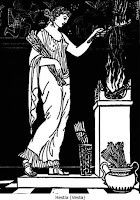Halloween seems to be the one mainstream celebration that is universally credited to the ancient Pagans... and yet many would be surprised to learn that the holiday actually traces back to a Christian celebration. So how have Roman and Celtic festivals for the dead blended with Catholic influences to form the modern day Halloween celebrated in communities today?
Samhain of Ancient Celts
During the days of the ancient Celtic people, [who occupied the area that is now Ireland, the United Kingdom and Northern France some 2,000 years ago], the year was dissected by the four seasons -- the last of which they prepared for on November 1st:
Winter. Dark and cold. The start of this time meant the end of harvest and on the eve before this barren season was to start, ancients celebrated by honoring the death of the sun and, in-turn, remembering their own dead. It began with the fire in their hearth, which they would extinguish to represent the end of summer and the dying light.
Large bonfires were raised in communities where celebrations included dancing in costumes consisting of animal heads and skins.
[1] When the festivities concluded, each family would bring home a burning piece of the ceremonial fire. They would use the flames to reignite their hearths, blessing the fire in honor of the sun; hopeful that its warmth and light would get them through the cold, dark winter nights.
Lemuria of Pagan Rome
Ancients of pre-Christian Rome celebrated the festival of Lemuria on May 13th. During this "Lemuria/Lemuralia", rites were performed to exorcise the
lemures [restless malevolent spirits]. Priestesses of the Goddess Vesta [
goddess of the hearth] would prepare offerings of beans and sacred flour cakes [made from the first ears of seasonal wheat].
[2]
Conversion Intentions by Catholic Popes
So what link connects Halloween to a Roman festival in spring and Celtic celebration in fall? Enter: The Catholic Church.
Around 609-610 Pope Boniface IV dedicated the Pantheon in Rome to the Virgin Mary and all Martyrs, converting it into a Christian Church and thusly establishing the feast of
dedicatio Sanctae Mariae ad Martyres.
[3]
This is the first known instance in Rome of transformation of a Pagan temple into a site for Christian worship. The date of this conversion, May 13th, is not likely to be coincidental and is believed to have occurred in attempt by the Catholic Church to de-Paganize Rome.
In the 8th century, Pope Gregory III founded an oratory for the relics
"of the holy apostles and of all saints, martyrs and confessors, of all the just made perfect who are at rest throughout the world".
Pope Gregory III added saints to the celebration of Boniface IV's martyrs, calling it All Saint's Day [or All Hallowmas from the Middle English for
Alholowmesse].
[4]
Additionally, Pope Gregory III moved the date of the sacred feast from May 13th to November 1st in attempt to envelope the Celtic celebration of Samhain; hopeful for a smooth conversion of Ireland to Christianity.
Over time, Samhain celebrations merged with those enjoyed on the eve of All Saint's Day, called All Hallow's Eve and, eventually,
'Halloween' [first attested in the 16th century].
( [5] The Oxford English Dictionary (2nd ed.). Oxford: Oxford Univ. Press. 1989. ISBN 0-19-861186-2.)
We often hear from conservative Christians about the evil Pagan roots of our modern holiday and yet the irony proves hysterical when we consider that the day is celebrated today because of its connections to the Catholic Church and its intentions to convert the Romans, Celtics and Gaels by overshadowing local festivals with comparable observances of their own.
Speaking of conservative Christians...
Recently a very slanderous and ignorant opinion article was posted in
Business Week unleashing harsh and inaccurate depictions of Paganism's grips on an otherwise Christian-West [through the celebration of Halloween].
[6]
The author, Amity Schlaes, states "
Halloween isn’t secular. It is pagan. There’s nothing else to call a set of ceremonies in which people utter magical phrases, flirt with the night and evoke the dead." It wasn't long at all before Mrs. B of the popular blog
Confessions of a Pagan Soccer Mom and other icons from the Witching World enlightened our research-deprived Mr. Schlaes with counterresponses containing references to the actual origins of America's Halloween.

Truth be told, Halloween and Samhain are two separate holidays, among many across the globe, which happen to fall on the same date during the year.
Mrs. B commented "Cultures, including those that follow Christian faiths, honor their ancestors this time of year all over the world. Why focus just on those people of Pagan faiths? Seems a little like religious persecution to me. "
When will we see a time when supposed reputable sources for news, such as Business Week, demand more [ie, the truth] from authors submitting articles to their publications? Let's leave the spewing of lies to the tabloids, shall we?!
Happy Halloween, Samhain, Day of the Dead, Ten Chieh, Yue Lan, Alla Helgans Dag & many many more!




